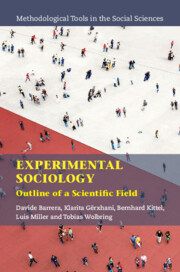Book contents
- Experimental Sociology
- Methodological Tools in the Social Sciences
- Experimental Sociology
- Copyright page
- Contents
- Figures, Tables, and Boxes
- Preface
- 1 Introduction
- Part I The Philosophy and Methodology of Experimentation in Sociology
- Part II The Practice of Experimentation in Sociology
- Part III Methodological Challenges of Experimentation in Sociology
- References
- Index
- References
References
Published online by Cambridge University Press: 23 November 2024
- Experimental Sociology
- Methodological Tools in the Social Sciences
- Experimental Sociology
- Copyright page
- Contents
- Figures, Tables, and Boxes
- Preface
- 1 Introduction
- Part I The Philosophy and Methodology of Experimentation in Sociology
- Part II The Practice of Experimentation in Sociology
- Part III Methodological Challenges of Experimentation in Sociology
- References
- Index
- References
- Type
- Chapter
- Information
- Experimental SociologyOutline of a Scientific Field, pp. 159 - 191Publisher: Cambridge University PressPrint publication year: 2024

